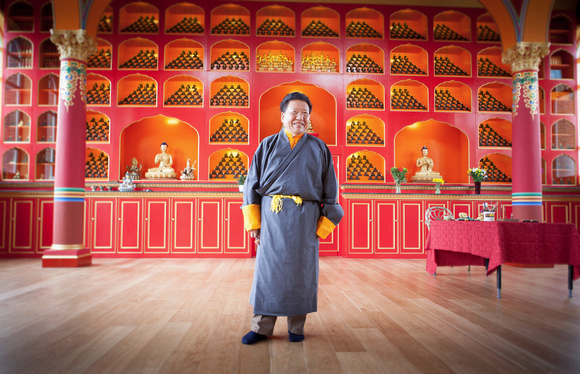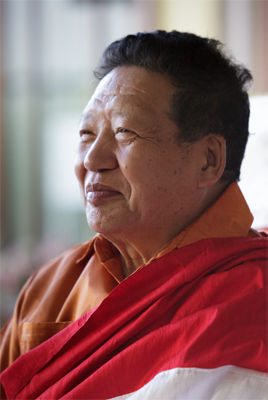
On the morning of Tuesday, October 8, the prominent Tibetan lama, doctor, and humanitarian Akong Rinpoche was stabbed to death in a residential community in Chengdu, Sichuan Province, along with his nephew and monk attendant. The tragic ending of his life reflected his lifelong commitment to tasks and ideals that, to a degree exceptional among Tibetan lamas in the West, were difficult, controversial, and far-reaching in their implications.
Born in eastern Tibet in 1939 or 1940, Akong Tarap left for exile in India in 1959, a journey which led him to see hunger as the most basic of all human needs, and to strive to eradicate it. In the early 1960s, he was one of the first Tibetan tulkus to be brought from exile to Western Europe, along with the young lama Chögyam Trungpa, who would later move to the US and found what would become Shambhala International. Akong remained in Britain, overseeing the community at Samyeling, the first Tibetan Buddhist center in Europe, in a secluded part of southern Scotland that would be his home for the remainder of his life.
While Trungpa became celebrated in the US for his unorthodox but brilliant teachings, Akong was known for his avoidance of publicity and for the rugged determination and earthiness of his teaching style. But he shared with Trungpa an unusually clear-sighted and resolute, even forceful, approach to the work of a lama, and an utter fearlessness toward controversy, pursuing the objectives that he set himself irrespective of public opinion.
Unlike almost all Tibetan lamas in the West, Akong’s objectives were social and humanitarian as well as spiritual: he was a karma yogi, committed to the path of action. While he made sure that he was available to teach and assist his religious followers and preserve the traditions and learning of his heritage, the bulk of his life’s work was focused on providing social welfare to villagers, rural communities, townspeople, nomads, and monasteries in Tibet. His humanitarian concerns were nonsectarian and multinational, and he founded welfare projects in China, Nepal, South Africa, and Zimbabwe, as well as soup kitchens in the UK, Nepal, South Africa, Poland, and Belgium.
These initiatives were organized by a group, cofounded with the Swiss philanthropist Lea Wyler in 1980, called Rokpa, the Tibetan word for “help.” From 1990 onward, after seven years of negotiation with Chinese officials, he established the first of over 150 projects in Tibet, which came to include schools, clinics, orphanages, vocational training centers, and environmental projects, all oriented toward cultural preservation and sustaining Tibetan language.
Several exile Tibetans have developed valuable welfare projects around their own monasteries or birthplaces in Tibet, but Akong was the only one to have done so on this scale throughout the Tibetan plateau. He did so with little public profile, and often with very limited funding. Considering the extraordinary deftness in dealing with Chinese authorities that such endeavors required, this was an historic achievement, and one that we may not see again.
 The larger significance of his skills became evident in 1992 when Akong became the key figure in an issue of international consequence: he led the search team within Tibet for the reincarnation of the 16th Karmapa. This was the first time that exile Tibetan lamas, led by Situ Rinpoche, had risked inviting the Chinese authorities to work with them on the search for a reincarnation. It represented a breakthrough, visionary moment in Tibetan-Chinese relations: instead of taking a child secretly to be educated in exile in India, as had happened in almost all prior cases, the agreement brokered by Akong and others allowed the child to be educated in his homeland, but with access to exile teachers.
The larger significance of his skills became evident in 1992 when Akong became the key figure in an issue of international consequence: he led the search team within Tibet for the reincarnation of the 16th Karmapa. This was the first time that exile Tibetan lamas, led by Situ Rinpoche, had risked inviting the Chinese authorities to work with them on the search for a reincarnation. It represented a breakthrough, visionary moment in Tibetan-Chinese relations: instead of taking a child secretly to be educated in exile in India, as had happened in almost all prior cases, the agreement brokered by Akong and others allowed the child to be educated in his homeland, but with access to exile teachers.
This rare instance of cooperation between Chinese authorities and Tibetan exiles, including the Dalai Lama, would likely have been the basis for major improvement in Tibetan-Chinese relations, had Beijing’s policy not hardened sharply the following summer. As a result, Situ was banned from China, Akong was blocked from access to the central Tibetan areas (the Tibet Autonomous Region), and the young Karmapa, then the most influential lama in Tibet, was denied contact with his exile teachers and fled to India nine years later, where he currently remains.
Like all of Akong’s initiatives, this effort came at a great personal cost. Due in part to conflict with sectarian opponents, the Indian secret services were persuaded to treat him, Situ Rinpoche, and the Karmapa as being under some form of Chinese influence. No credible evidence of any kind has ever been produced to support these accusations; despite all his visits to China and his meetings with officials, Akong rarely said or indicated anything in public that could be used by either side politically. He possessed a deeply ingrained understanding of diplomacy, building bridges between erstwhile enemies by avoiding any public flourishes that might damage practical progress on the ground. Probably satisfying neither party, he gained respect from both, the depths of which are shown by the silence that both governments have tactfully maintained since his death, rather than claim his achievements for themselves.
Akong focused the rest of his life on developing his social welfare projects within Tibet and other countries, as well as overseeing the teaching community at Samyeling, which since the 1990s has been under the direct guidance of his brother, Lama Yeshe Losal Rinpoche. Now with 33 branches in ten countries, including three centers for long-term retreats, Samyeling houses one of the largest Tibetan Buddhist temples in Europe, inaugurated in 1988. Akong also worked to apply traditional Tibetan medicine to modern needs, and in 1990 founded a project called the Tara Trust to develop practical forms of psychotherapy and systems for identifying, collecting, and protecting medicinal herbs used in Tibetan medicine. The lama spent five months of every year visiting his projects.
It was typical of Akong to agree to meet the Tibetan, a monk and statue-maker who had worked for several years at Samyeling, when he demanded to see him at his residence in Chengdu in early October. The former monk showed up with two companions, and it was these three Tibetans who have been charged with the stabbing attack, reportedly after failing to obtain money that Akong brought to distribute to his projects. He refused to hand it over.
There was widespread speculation among Tibetans and others, fueled by confusing reports from the local police, that the deaths must have been a result of political conspiracy or sectarian conflict. But it is sadly clear that atavistic notions of honor, masculinity, greed, and blood-vengeance, deeply rooted in areas of Tibetan society, were the driving factors in these deaths. The murders are a reminder of the overriding importance of pioneering social and spiritual leaders such as Akong Rinpoche in the long project of rebuilding society and community in Tibet, as well as in the delicate effort to develop and sustain practical forms of Tibetan-Chinese cooperation.